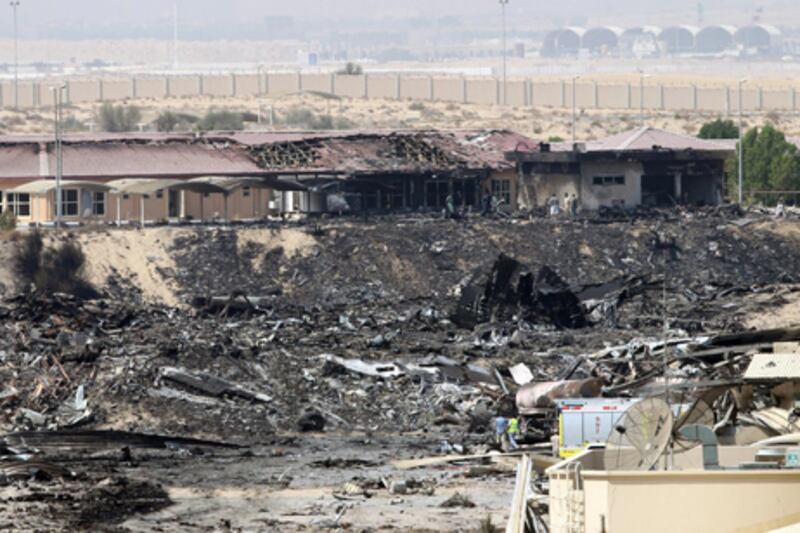DUBAI// Flight crew should be trained in a simulator that replicates fire, smoke and fumes in the cockpit, the investigation into a fatal cargo-plane crash in Dubai has recommended.
Investigators also propose a task force to study the safe transport of hazardous cargo such as lithium batteries, which ignited on board UPS Flight 6 on September 3, 2010.
The 322-page final incident report released yesterday by the General Civil Aviation Authority confirmed the cause of the fire suggested in a preliminary report in 2011.
It made 36 recommendations to prevent similar crashes, including a review of the hazardous material classification of lithium batteries, systems to detect cargo fires earlier and compulsory devices to improve pilot visibility in smoke.
The crew had reported smoke in the cockpit soon after take-off from Dubai en route to Germany. Bahraini air traffic control suggested the plane land in Doha, 100 nautical miles away, but the pilot chose to return 185 nautical miles to Dubai.
As the cockpit filled with smoke and equipment failed, the plane was too high on its approach and overshot the airport. It made a tight turn and crashed near Nad Al Sheba military base. The outcome if they had diverted to Doha was inconclusive, the report said.
Both crew on the Boeing 747-400 died: Captain Doug Lampe, 48, from Kentucky, and First Officer Matthew Bell, 38, from Florida.
The GCAA team worked on the three-year investigation with UPS, Boeing, the National Transportation Safety Board in the US and the US Federal Aviation Administration.
“A number of independent fire tests have been performed, and reconstruction of the aircraft critical systems was undertaken to establish the root cause of the aircraft’s failures,” said Saif Mohammed Al Suwaidi, director general of the GCAA.
“We aim through this report to help the local and the international aviation industry to conclude important lessons for a safer and more secure aviation industry.”
Among the recommendations was a suggestion for smoke, fire and fumes training for crew members in a simulator that would allow them “to experience actual levels of continuous smoke.”
The report also said an International Civil Aviation Organisation task-force should be established to study the safe carriage of lithium batteries and other hazardous cargo.
Shippers of some of the batteries loaded on to the plane in Hong Kong “did not properly declare these shipments” and did not provide battery test reports in compliance with UN recommendations, the report found.
The contents of a cargo pallet with lithium batteries auto-ignited and started a fire that was not sensed by smoke detectors in its early stages.
“The fire escalated rapidly into a catastrophic and uncontained fire,” the report said.
Heat from the fire damaged control cable assemblies, which compromised the aircraft’s control mechanisms. And the cargo compartment liner failed as a fire and smoke barrier, meaning that the cockpit was exposed to “sustained and persistent smoke and toxic fumes”.
“The crew made several comments concerning their inability to see anything in the cockpit,” the report said.
Capt Lampe and First Officer Bell put on oxygen masks, but they were not enough to protect them as the fire raged.
As they struggled to complete their checklists and land the plane using autopilot, Capt Lampe’s oxygen supply stopped without warning, possibly because of the failure of the hose. While he was looking for a supplementary oxygen bottle, he was overcome by the fumes, the report said. He died from carbon monoxide inhalation.
First Officer Bell took over the plane but had breathing difficulties and faced an “extreme workload” alone, the report said. The flight also remained on the frequency of Bahraini air traffic controllers; First Officer Bell could not see the panels to change the frequency.
Dubai controllers knew the flight was in emergency status, but were not sure of the specific nature of the emergency because of the “complex nature of the relayed communications”, the report said.
As First Officer Bell tried to land with minimal manual control he was “unaware of the large urban area directly in the airplane’s path”, the report said.
The plane came down near a busy junction but crashed into a service road, maintenance storage buildings and a sand bank. No one on the ground was injured.






